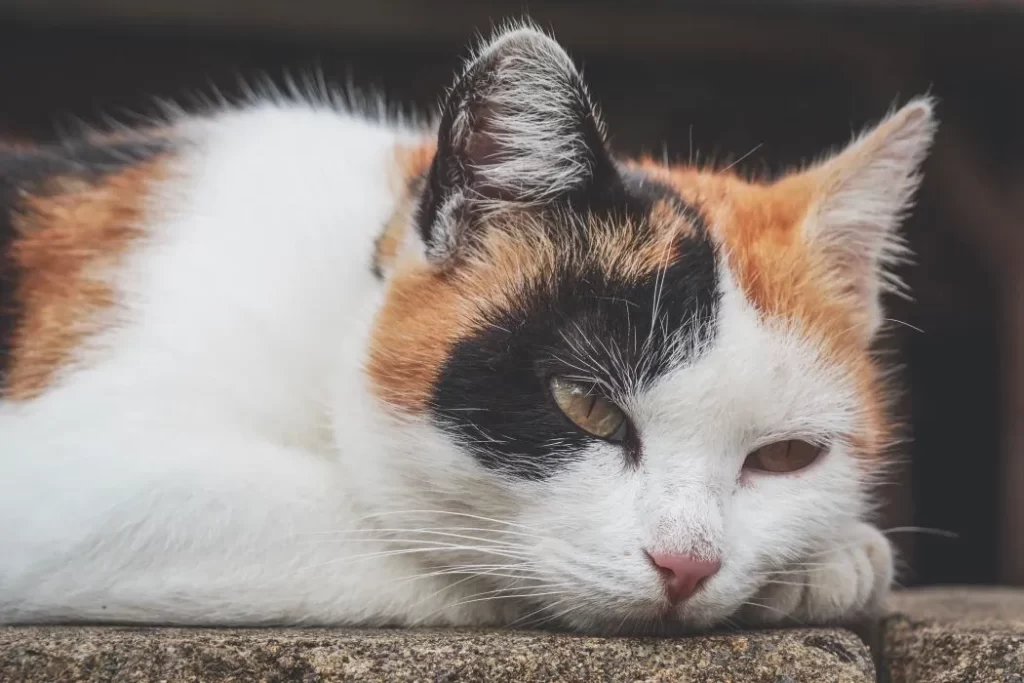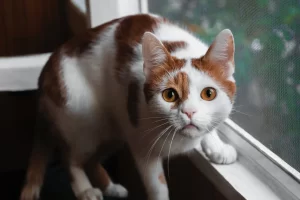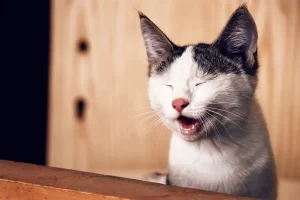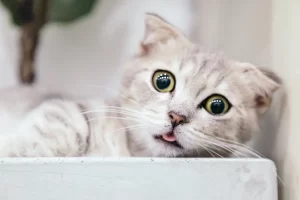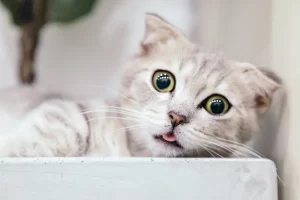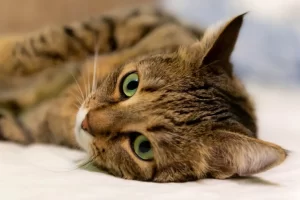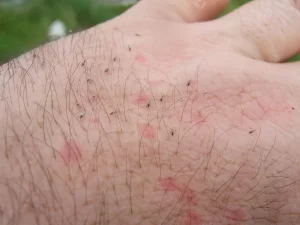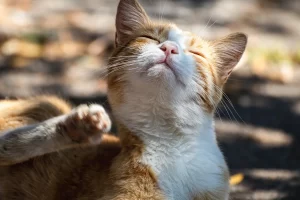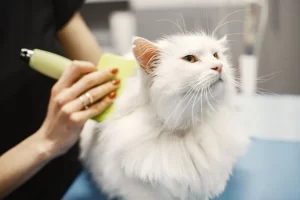Vestibular disease in cats is a condition that affects the balance and coordination of the cat’s body. It is a common condition and can have a range of causes, including inner ear infections, tumors, and aging. While some cases of the vestibular disease require medical treatment, there are many home remedies and treatments that can help manage the symptoms and improve your cat’s quality of life. These treatments include dietary modifications, herbal remedies, environmental modifications to improve balance, and alternative therapies such as acupuncture. It is important to consult a veterinarian if you suspect that your cat has the vestibular disease, as early treatment can help minimize the risk of potential complications.
If you prefer to listen on-the-go, be sure to check out the audio version of this blog below!
Table of Contents
ToggleWhat is a vestibular disease in cats?
Vestibular disease in cats is a condition that affects the vestibular system, which is responsible for controlling balance and coordination. It results in symptoms such as head tilt, dizziness, unsteadiness, and nystagmus (involuntary eye movements). The exact cause of vestibular disease in cats is often unknown, but it can be related to inner ear infections, brain tumors, and other neurological issues.
Symptoms of vestibular disease in cats
The 10 most common symptoms of vestibular disease in cats are:
- Head tilt: One of the most noticeable symptoms of vestibular disease in cats is a head tilt, which can be to one side or the other. This head tilt can also change from time to time.
- Dizziness: Cats with the vestibular disease may appear unsteady or disoriented. They may have trouble walking straight or stumble while trying to walk.
- Unsteadiness: The vestibular system is responsible for maintaining balance, so cats with the vestibular disease may have trouble walking or standing still.
- Nystagmus: This refers to rapid, repetitive eye movements that usually side to side or up and down. Nystagmus is a sign of a vestibular problem and can make it difficult for a cat to focus its gaze.
- Loss of balance: Cats with the vestibular disease may have trouble staying upright and may fall over or stumble frequently.
- Falling over: Vestibular disease can cause a cat to lose its balance and fall over, especially when trying to stand up or walk.
- Circling: Some cats with the vestibular disease may circle in one direction, which can be a sign of an inner ear problem.
- Loss of appetite: Due to nausea and unsteadiness, cats with the vestibular disease may lose their appetite.
- Vomiting: Vestibular disease can cause nausea and vomiting in some cats, which can make it difficult for them to keep food down.
- Hearing loss: In severe cases of vestibular disease, cats may experience hearing loss. This can make it difficult for them to navigate their environment and respond to sounds.
Causes of vestibular disease in cats
The exact cause of vestibular disease in cats is often unknown, but it can be related to several factors including:
- Inner ear infections: Vestibular disease can be caused by infections in the inner ear, which can lead to inflammation and affect the vestibular system. Help your cat fight ear infections by learning more about this complication and how it can be addressed at home.
- Brain tumors: Brain tumors can cause vestibular disease by putting pressure on the vestibular system and affecting its function.
- Strokes: Vestibular disease can be a result of a stroke, which is caused by a disruption of blood flow to the brain.
- Trauma to the head or neck: Trauma to the head or neck can cause vestibular disease by damaging the vestibular system and its associated nerves.
- Degenerative diseases of the central nervous system: Some cats may develop the vestibular disease as a result of degenerative diseases of the central nervous system, such as feline hypertension.
- Certain medications: Some medications can have adverse effects on the vestibular system and cause vestibular disease as a side effect.
- Toxins or poisons: Exposure to certain toxins or poisons can damage the vestibular system and cause vestibular disease. If you are not sure what toxins might have cause vestibular disease in your cat, check out our post on What Toxins Cause Vestibular Disease in Cats?
- Idiopathic (unknown) causes: In some cases, the exact cause of vestibular disease in cats may be unknown and considered idiopathic.
Vestibular disease can occur in cats of any breed, age, or gender. However, some factors can increase the risk of vestibular disease, such as:
- Age: Older cats are more likely to develop vestibular disease due to the natural aging process and associated changes in the inner ear.
- Breeds: Certain breeds, such as Siamese cats and Himalayan cats, may be more prone to vestibular disease due to genetic factors.
- Gender: There is no evidence to suggest that vestibular disease is more common in cats of a certain gender.
Diagnosis of vestibular disease in cats
Diagnosis of vestibular disease in cats typically involves a thorough physical examination, as well as laboratory tests and imaging studies. The following steps may be involved in diagnosing vestibular disease in cats:
- Physical examination: The veterinarian will perform a thorough physical examination to assess the cat’s symptoms and look for signs of vestibular disease.
- Laboratory tests: Blood work and other laboratory tests may be performed to rule out other conditions that could cause similar symptoms.
- Imaging studies: Imaging studies, such as CT scans or MRI, may be performed to visualize the inner ear and assess for any structural abnormalities that could cause vestibular disease.
- Otoscopic examination: An otoscopic examination may be performed to examine the inner ear and check for signs of infection or other abnormalities.
- Neurological evaluation: A neurological evaluation may be performed to assess the function of the vestibular system and other areas of the central nervous system.
- Other tests: Depending on the case, other tests such as a brainstem auditory evoked response test may be performed to assess hearing and other related functions.
Based on the results of these tests, the veterinarian can make a diagnosis of vestibular disease in cats and develop a treatment plan.
Prognosis of vestibular disease in cats
The prognosis for vestibular disease in cats depends on the underlying cause, the severity of symptoms, and the promptness of treatment. Some cases of the vestibular disease may resolve on their own or with supportive care, while others may require more aggressive treatment or result in permanent deficits.
- Idiopathic cases: In some cases of idiopathic (unknown) vestibular disease, the symptoms may resolve on their own within a few days to a few weeks, and the cat may recover fully.
- Treatable causes: If the vestibular disease is caused by an underlying condition that is treatable, such as an inner ear infection or a brain tumor, the prognosis may be more favorable.
- Chronic cases: In some cases, the vestibular disease may be a chronic condition that requires ongoing management, and the cat may experience some permanent deficits.
In general, prompt and appropriate treatment can improve the prognosis for vestibular disease in cats, so it is important to seek veterinary care as soon as symptoms are noticed.
Read More: How often do you take a cat to the vet?
Vestibular disease in cats: Home treatments
- Provide a safe environment: Create a safe and comfortable environment for your cat to help them adjust to their symptoms.
- Offer food and water: Provide small, frequent meals and offer water in a shallow dish to help prevent spills.
- Medications: Prescription medications such as anti-nausea drugs, anti-inflammatory drugs, or steroids may be prescribed by a veterinarian to manage symptoms.
- Physical therapy: Gentle physical therapy, such as head and neck exercises, may be recommended to help improve balance and coordination.
- Use of a Thundershirt: Using a Thundershirt or other calming aid may help reduce anxiety and stress related to vestibular disease.
- Acupuncture: Acupuncture may be used to help manage symptoms and improve overall well-being.
- Adaptive equipment: Using adaptive equipment, such as a ramp or steps, may make it easier for your cat to move around and access food and water.
- Encouragement of activity: Encouraging your cat to move around and be active, as tolerated, can help improve their balance and coordination.
- Essential oils: The use of essential oils, such as lavender or chamomile, may help reduce anxiety and stress.
- Massage therapy: Massage therapy may be used to help improve circulation, relieve muscle tension, and promote relaxation.
- Herbal remedies: Herbal remedies, such as ginger or valerian root, may be used to manage symptoms, but it is important to discuss their use with a veterinarian first.
- Vitamin supplements: Vitamin supplements, such as vitamin B, may be recommended to help improve overall health and manage symptoms.
- Good nutrition: Feeding a balanced and nutritious diet can help improve overall health and manage symptoms.
- Hydration: Making sure your cat stays hydrated can help manage symptoms and improve overall well-being.
- Stress reduction: Reducing stress and providing a calm environment can help manage symptoms and improve overall well-being.
It is important to consult a veterinarian before trying any home remedies or treatments for the vestibular disease in cats, as some remedies may interact with other medications or worsen symptoms.
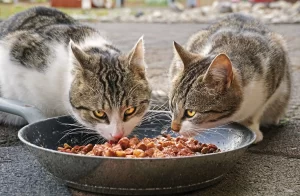
Proper diets, nutrition, and supplements for cats with Vestibular disease
Diet Recommendations:
- High-quality, balanced diet: Feeding a high-quality, balanced diet can help improve overall health and manage symptoms of vestibular disease in cats.
- Small, frequent meals: Offer small, frequent meals to help reduce nausea and manage any appetite changes.
- Hydration: Encourage your cat to drink water, as staying hydrated can help manage symptoms and improve overall well-being.
Nutrition Recommendations:
- Omega-3 fatty acids: Omega-3 fatty acids, such as those found in fish oil, may help reduce inflammation and improve overall health.
- Antioxidants: Antioxidants, such as vitamins A, C, and E, can help protect cells from damage and improve overall health.
- B vitamins: B vitamins, such as vitamin B12, may help improve overall health and manage symptoms.
Supplement Recommendations:
- Ginger: Ginger can help reduce nausea and improve digestion. Offer in small amounts, such as 1/8 to 1/4 teaspoon, mixed in with food.
- Valerian root: Valerian root may help reduce anxiety and stress. Offer in small amounts, such as 1/8 to 1/4 teaspoon, mixed in with food.
- Vitamin B complex: Vitamin B complex can help improve overall health and manage symptoms. Follow the recommended dosage on the product label.
It is important to consult a veterinarian before starting any new diets, nutrition, or supplements, as they may interact with other medications or worsen symptoms.
Herbal remedies
- Ginger: Ginger can help reduce nausea and improve digestion. Offer in small amounts, such as 1/8 to 1/4 teaspoon, mixed in with food.
- Valerian root: Valerian root may help reduce anxiety and stress. Offer in small amounts, such as 1/8 to 1/4 teaspoon, mixed in with food.
- Chamomile: Chamomile may help reduce anxiety and improve overall well-being. Offer as a tea, or add dried chamomile to food.
- Lavender: Lavender may help reduce anxiety and improve overall well-being. Offer as a tea, or add dried lavender to food.
- Echinacea: Echinacea may help improve the immune system and overall health. Offer as a tea, or add dried echinacea to food.
- Milk thistle: Milk thistle may help improve liver function and overall health. Offer as a tea, or add dried milk thistle to food.
- Ginkgo biloba: Ginkgo biloba may improve circulation and overall well-being. Offer as a tea, or add dried ginkgo biloba to the food.
Environmental modifications to improve balance in cats with Vestibular disease
Environmental modifications to improve balance for cats with vestibular disease can include:
- Stable surfaces: Provide stable, slip-resistant surfaces for your cat to walk on, such as rugs or non-slip flooring.
- Easy access to food and water: Keep food and water bowls in accessible locations to reduce the need for your cat to move around.
- Safe hiding spots: Provide safe hiding spots, such as a cozy bed or box, for your cat to retreat to if they feel unsteady or overwhelmed.
- Avoid high surfaces: Avoid placing your cat on high surfaces, such as counters or tables, as this can increase their risk of falling.
- Stair assist: If your cat lives in a multi-level home, consider installing ramps or steps to help them safely navigate stairs.
- Limited access to hazardous areas: Limit your cat’s access to hazardous areas, such as staircases or areas with sharp edges, to reduce their risk of injury.
- Consistent furniture placement: Keep furniture in consistent locations to help your cat orient themselves and maintain their balance.
Consult a veterinarian before making any environmental modifications, as they may need to be tailored to the individual cat’s specific needs and abilities.
Medications and over-the-counter medicines to treat vestibular disease in cats
Medications, medicines, and over-the-counter medicines used to treat vestibular disease in cats can include:
- Anti-nausea medications: To control nausea and vomiting, your veterinarian may prescribe anti-nausea medications, such as maropitant or ondansetron.
- Steroids: To reduce inflammation and swelling, your veterinarian may prescribe steroids, such as prednisone or dexamethasone.
- Antibiotics: If an underlying infection is causing vestibular disease, your veterinarian may prescribe antibiotics, such as amoxicillin or doxycycline.
- Vestibular suppressants: To reduce vertigo and dizziness, your veterinarian may prescribe vestibular suppressants, such as meclizine or diazepam.
- Vitamin B complex: To support nerve and brain function, your veterinarian may recommend vitamin B complex supplements.
It is important to follow your veterinarian’s instructions when administering any medications or supplements to your cat. Over-the-counter remedies should only be used under the guidance of a veterinarian, as they may interact with other medications or worsen symptoms.
Alternative therapies for vestibular disease in cats
Alternative therapies for vestibular disease in cats can include:
- Acupuncture: This therapy uses the insertion of fine needles into specific points on the body to stimulate healing and promote balance.
- Physical therapy: Physical therapy can help your cat regain balance and coordination. Exercises may include balance boards, obstacle courses, and controlled walking.
- Chiropractic: Chiropractic care involves manual adjustment of the spine and joints to restore proper movement and alignment.
- Massage: Massage can help your cat relax and improve circulation, which can promote healing and reduce symptoms.
- Aromatherapy: Aromatherapy involves the use of essential oils to promote relaxation and improve symptoms.
- Herbal remedies: Herbs such as ginger, ginkgo biloba, and skullcap can be used to improve circulation and support the nervous system.
Prevention of vestibular disease in cats
Prevention of vestibular disease in cats can be difficult, as the causes of the condition are not always known. However, the following steps may help reduce the risk of vestibular disease in cats:
- Maintaining good overall health: Feeding a balanced diet, providing regular exercise, and maintaining good hygiene can help keep your cat healthy and reduce the risk of vestibular disease.
- Preventing infections: Regular veterinary check-ups and vaccinations can help prevent infections that may lead to vestibular disease.
- Avoiding toxins: Keeping your cat away from toxic substances, such as household cleaners, pesticides, and certain plants, can help reduce the risk of vestibular disease. Read more about keeping toxins away here.
- Monitoring for changes: Regularly monitoring your cat for changes in behavior, appearance, or health can help detect vestibular disease early and improve the prognosis.
- Providing a safe and stable environment: Providing a safe and stable environment, free of sharp objects, slippery surfaces, and high places, can help prevent falls and reduce the risk of vestibular disease.
It is important to remember that vestibular disease can have many causes and that some cases may not be preventable. However, maintaining good overall health, preventing infections, and providing a safe and stable environment can help reduce the risk of vestibular disease in cats.
Coping with a cat with vestibular disease
Caring for a cat with the vestibular disease can be challenging, but there are ways to help you and your cat cope with the condition:
- Providing a safe environment: Creating a safe and stable environment, free of sharp objects and slippery surfaces, can help prevent falls and reduce the risk of further injury.
- Assisting with mobility: Helping your cat with mobility, such as carrying them up and down stairs, can reduce the risk of injury and help them get around.
- Encouraging exercise: Encouraging gentle exercise, such as playing with toys, can help improve balance and coordination.
- Helping with hygiene: Assisting with hygiene, such as bathing and grooming, can help maintain good hygiene and prevent infections.
- Managing symptoms: Following your veterinarian’s recommendations for managing symptoms, such as medication and dietary changes, can help improve your cat’s quality of life.
- Seeking support: Seeking support from friends, family, and other cat owners can provide emotional support and help you cope with the challenges of caring for a cat with vestibular disease.
- Being patient: Vestibular disease can be a slow process, and it may take time for your cat to recover. It is important to be patient and understand that improvement may be gradual.
Caring for a cat with the vestibular disease can be challenging, but with the right support, you and your cat can manage the condition and improve their quality of life.
potential complications if the vestibular disease is left untreated
Untreated vestibular disease in cats can lead to the following potential complications:
- Falls and injuries: If the vestibular disease causes balance and coordination issues, your cat may be at risk of falls and injuries.
- Dehydration and malnutrition: Vestibular disease can cause loss of appetite, leading to dehydration and malnutrition.
- Secondary infections: If the vestibular disease is caused by an underlying infection, it can lead to secondary infections if left untreated.
- Prolonged recovery: If the vestibular disease is not treated, recovery may be prolonged, leading to ongoing symptoms and decreased quality of life.
- Chronic vestibular disease: In some cases, the vestibular disease can become chronic, leading to ongoing symptoms and decreased quality of life.
- Euthanasia: In severe cases, if the vestibular disease causes significant pain and suffering, euthanasia may be recommended.
Which vet to visit with what specialties for vestibular disease
If you suspect that your cat has the vestibular disease, it is best to consult a veterinarian. Depending on the cause of the vestibular disease, your veterinarian may refer you to a specialist with the following specialties:
- Neurologist: A veterinarian who specializes in the diagnosis and treatment of neurological conditions, including vestibular disease.
- Ear, nose, and throat specialist (ENT): A veterinarian who specializes in the diagnosis and treatment of conditions affecting the ear, nose, and throat, including vestibular disease caused by inner ear infections.
- Neuro-ophthalmologist: A veterinarian who specializes in conditions affecting the nervous system and eyes, including vestibular disease that affects eye movements.
- Internal medicine specialist: A veterinarian who specializes in diagnosing and treating internal medical conditions, including vestibular disease caused by underlying medical conditions.
- Oncologist: A veterinarian who specializes in the diagnosis and treatment of cancer, including vestibular disease caused by tumors.
Costs of treating vestibular disease
The cost of treating vestibular disease in cats can vary widely depending on the underlying cause and the extent of the treatment required. Here are some approximate costs for some common steps in the treatment of vestibular disease in cats:
- Initial veterinary consultation: $50-$200
- Diagnostic tests (e.g. blood work, X-rays, MRI): $200-$1,000
- Medications: $20-$100 per month
- Alternative therapies (e.g. acupuncture, physical therapy): $50-$150 per session
- Specialist consultation (e.g. neurologist, ENT specialist): $200-$500
- Surgery (e.g. removal of a tumor): $1,000-$3,000
- Hospitalization: $100-$300 per day
It is important to keep in mind that these are rough estimates and that the actual cost of treating vestibular disease in your cat will depend on several factors, including the underlying cause, the extent of the treatment required, and the location of your veterinarian. Additionally, the cost of treating vestibular disease can quickly add up, so it is a good idea to discuss the expected costs with your veterinarian and to plan for any financial expenses in advance.

